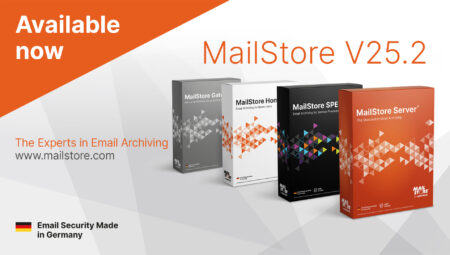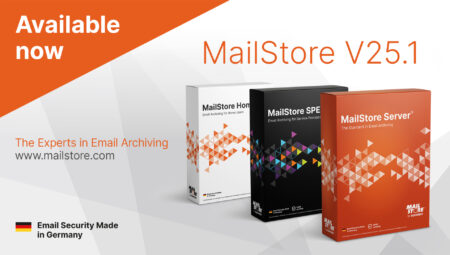
Email Archiving vs. Backups – The Critical Differences
Even if cloud-based, integrated communication environments such as Microsoft Teams are becoming increasingly popular in terms of digital collaboration, email remains the most important means of communication for companies around the world. According to statista.com, the volume of emails sent and received is set to rise to an estimated 376 billion by 2025. And do you always keep in mind that your emails can contain business-critical data that need to be protected and kept available in the long term?
Email compliance regulations are constantly growing and so are, therefore, the legal requirements governing the handling of such data. So, it is essential that IT decision-makers get to grips with the issue of retaining and protecting email data. Backups and email archiving concepts can provide valuable help, and for this reason should form part of any corporate IT strategy (data security and email governance). Global companies need to remember that compliance requirements can vary from country to country.
In our blog article, we want to show you how backup and email archiving concepts can be deployed, where the differences between the two procedures lie, and how you can benefit from a professional email archiving solution.
Archiving vs Backups: Goals and Differences
Essentially, both backup and email archiving solutions can help a company secure business-critical data so that this valuable information is permanently available. However, as both solutions differ in terms of functionality, it’s important to understand how and when each should be used. It even makes sense to deploy a backup and an email archiving solution in tandem.
First and foremost, the objective of any email archiving solution is to store copies of all emails including their file attachments for many years in a form that is faithful to the original, quick to find, and permanently available. Even if the email server is temporarily unavailable, the archived emails are still accessible. For a company, this is particularly important in the case of emails involved in the preparation, completion, execution or reversal of transactions (e.g. invoices, quotations, support inquiries, or appointment requests).
In contrast, the purpose of a backup is to store data (e.g. emails) and systems (e.g. the email server) regularly in the short and medium term, thus providing a snapshot of the saved data. This concept allows copies of entire data sets to be made so that they can be swapped out to external storage or to a cloud environment. Should an incident occur (e.g. data are lost due to system failure or as a consequence of a ransomware attack), the temporary, backed up data sets can be copied back from external storage. Thus, a backup is primarily a means of disaster recovery.
The following objectives can be achieved through iThe statements in this document are based on the fundamental concepts of backups and email archiving. The functions of an email archiving solution discussed here are based on the range of functions provided by MailStore Server. The functions of backup and email archiving solutions may vary depending on the provider.email archiving1:
| Objectives | Email Backups | Email Archiving |
| Eliminate mailbox quotas | ||
| Eliminate PST files | ||
| Reduce storage requirements through de-duplication and compression | ||
| Reduce the workload of email servers and simplify backup and restore processes | ||
| Provide complete, tamper-proof and long-term email retention | ||
| Helps to meet compliance requirements | ||
| Assistance with eDiscovery scenarios | ||
| Full-text indexing of emails for fast searches | ||
| End users: restore lost emails quickly and easily |
The 9 Benefits of an Email Archiving Solution
Archiving emails is an important component in terms of fully exploiting all the crucial information contained in emails, and one which – depending on the archiving method used – can deliver many benefits.
1. Eliminate Mailbox Quotas
With an email archiving solution, emails – once securely and permanently stored – can be deleted (automatically) from the email server’s mailboxes, thus freeing up space on the server. This also eliminates once and for all the need for mailbox quotas.
Backup solutions do not offer this benefit as they usually only create temporary copies of the email server’s data on an external storage medium or in the cloud. In this context, and, depending on the backup system used, “temporary” means that data within the backup are overwritten or deleted (in the case of an incremental backup, for instance). Alternatively, the data can be deleted completely according to a fixed schedule if the backup file is no longer needed. Since a backup does not store email data fully and permanently, the need for mailbox quotas still remains. Mailboxes operating at full capacity and, thus, the frequent necessity to “swap out” emails (e.g. to external PST files), remain a bugbear for users and IT administrators alike.
2. Eliminate PST Files
PST files are mainly used for transferring emails from a user’s mailbox (e.g. due to mailbox quotas), or for creating local copies of emails on a user’s PC. The contents of the mailbox are copied either manually or automatically (e.g. via the Microsoft Outlook function Auto Archive) to a PST file, then swapped out to an external storage medium, allowing the contents to be deleted from the user’s mailbox if necessary.
Many companies are trying to rid themselves of PST files altogether as the latter harbor certain risks. They are considered to be error-prone and inefficient, and often take up a lot of storage space. PST files are easily damaged or lost, particularly as they are often spread across various locations on the users’ PCs. This makes it more difficult to back up files, frequently resulting in the loss of key data. Moreover, PST files can’t be browsed using a full-text search function, neither are they tamper-proof.
In this regard, email archiving provides critical benefits for IT administrators, in particular. The emails are archived in a centrally administered system designed for long-term retention, while taking account of necessary regulatory and compliance requirements. This gives the IT administrator control over the entire archiving process. As the archived emails can be automatically deleted from the email server, PST files become redundant as a potential workaround for mailbox quotas. The contents of existing PST files can also be archived centrally, allowing end users to browse them with ease.
It’s also basically possible to back up PST files independently of an archiving process being used. However, as this approach doesn’t allow mailbox quotas to be bypassed, it’s not possible to fully eliminate PST files.
3. Reduce Storage Needs
Another advantage of email archiving is the ability to de-duplicate and compress archived emails, meaning that the archive uses less storage space.
And, while it’s true that a backup solution can also compress and – depending on provider – de-duplicate data, an email archiving solution has the added critical advantage of offloading the email server, as the latter no longer has to retain emails that have already been archived.
4. Simplify Backup & Restore Processes
Applying rules to delete emails from the server after successful archiving allows the volume of data kept on the server to be reduced. This can significantly increase the speed of a subsequent backup/restore procedure (in the event of data loss) of the email server, and thus substantially reduce the downtime of this business-critical system. As well as reducing the general data load on the email server, email archiving can also enhance the performance of the backup process. A backup solution can’t do this on its own. In addition, the email archive will still be available if the email server cannot be reached in the event of an emergency. This being the case, email archiving can make a valuable contribution in a business continuity scenario.
5. Tamper-proof Retention of Emails
The main aim of any email archiving solution is to retain email data in a form that is complete, tamper-proof, and permanently available in the future (see 6. Help with legal compliance).
Full data retention is usually achieved by archiving emails directly upon their arrival at or departure from the email server (known as journaling). A backup solution merely saves the email server in its current state (snapshot). Users might, therefore, delete email data before a backup has been completed, or suffer a major data loss for some other reason (e.g. a ransomware attack).
Professional email archiving solutions ensure that retained data is “tamper-proof” through encryption, the formation of hash values, restricting user privileges to a minimum, and keeping logs of relevant changes and user events. Some backup solutions are now also being marketed with tamper-proofing features – although this functionality does vary from provider to provider.
6. Help with Legal Compliance
Depending on the solution in place, archiving email data in a complete, tamper-proof and long-term manner helps to meet compliance requirements, as emails too can be subject to varying compliance requirements depending on the country and industry in question.
A key criterion for this to happen is the integrity of the data in question: with journal archiving, emails are archived the moment they are received or sent, while a backup usually follows a certain schedule and harbors the risk of tampering or data loss in the interim. Retention policies and GDPR options are supported by most email archiving solutions and, indeed, a number of backup solutions, although in the latter case, the configuration options often aren’t as user-friendly or comprehensive.
7. Help with eDiscovery Scenarios
Outside Anglo-American jurisdictions, eDiscovery is usually understood to mean the process by which electronically stored information is localized, procured, reviewed, and exchanged.
Both professional email archiving and backup solutions can help with eDiscovery scenarios as they usually provide a search as well as partial recovery and export functions. However, it’s important to keep in mind that the functions of a backup solution aren’t as comprehensive as those of an email archiving solution. If PST files contain emails (see also 2. Eliminating PST files), which in turn are stored in backups, eDiscovery scenarios could prove laborious and time-consuming. Here, the use of a complete email archive, which also contains the PST files originally used, would simplify the eDiscovery process significantly.
8. Full-text Indexing for Rapid Searches
Some professional email archiving solutions record the contents and metadata of archived emails and their attachments in a full-text index. Provided that the necessary privileges have been granted, this allows end users to search for certain emails quickly and efficiently by themselves in the live system without having to rely on the IT administrator. There are also email archiving solutions that offer this function through integration in Office applications, such as Microsoft Outlook. In certain cases, the email archiving solution can even map customary folder structures from the respective mailboxes, which makes searching for specific emails even easier. You can download our Info Sheet on Search Options in MailStore Server for End Users here.
Some backup solutions also offer search options, but these functions are generally reserved for the IT administrator and restricted to certain content and metadata.
9. End Users: Restore Lost Emails Easily
For end users, email archiving solutions offer advantages over backup solutions when it comes to recovery, too. End users are able to search for certain emails using the search function before recovering them independently. No additional IT capacity is required to restore emails, i.e. there is no need for the IT administrator to manually search backups for certain emails and restore them for the user. By contrast, backups don’t normally offer end users direct access to the data.
Important to Know: Ensuring Data Privacy
To avoid conflicts with data privacy regulations when archiving incoming and outgoing emails, we recommend prohibiting the use of private email or requiring that employees use only external email services. The policy can be specified in writing, for example, in guidelines for using the company’s IT infrastructure, in a company agreement, an employee’s declaration of consent, or an individual employment contract.
Conclusion: Email Archiving Is Not the Same as Creating Backups
Email archiving and backing up emails are two completely different solutions that pursue different objectives. Whereas backups are mainly designed to cope with disaster recovery scenarios and store data only for a limited period, the job of an email archiving system is to fully archive emails and their attachments over many years in a form that is tamper-proof and permanently available. Incidentally, it is important to note that the email archives themselves should be backed up as well. It follows, then, that both data backups and email archiving are key elements in the IT strategy of any security-conscious firm.
The differences between a backup and email archiving can be found in our free PDF Email Archiving vs. Email Backup for you to download:
If you are interested to see the functions of the email archiving solution MailStore Server in more detail, register for one of our regular, free live webinars:







